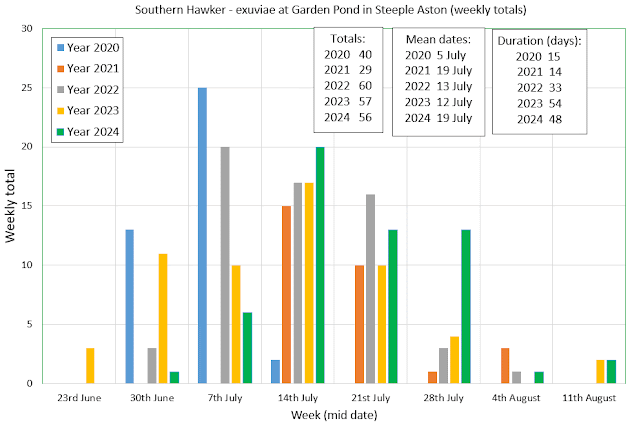Here is a brief summary of the main Odonata highlights for 2024 for the ceremonial county of Oxfordshire, which includes a large section of Vice County (VC) 22 (old Berks) and s small section of VC24 to the north (Whitecross Green Wood).
The weather for the 2024 dragonfly season was generally disappointing for much of the time, with fine sunny days at a premium. Numbers of the commoner species appeared well down, but there were still some notable highlights for some of the rarer species.
Unlike its exceptional showing in 2023, 2024 was more average for Clubtail sightings, with 18 records between 9 May and 2 June. Most were from the traditional area of Cholsey and Goring, with a notable count of 11 exuviae from downstream of Gatehampton Railway Bridge. There were also reports from the upstream section of Thames at Chimney Meadows, Shifford and Tadpole Bridge, where this species is seen less often.
 |
| Clubtail (c) Alan Dawson |
There was a better showing for Variable Damselfly, with 6 records. Most were from the usual Barton Fields area near Abingdon but two were from a site northwest of Oxford (Dukes Pond) - an area from which there have been intermittent reports previously.
 |
| Variable Damselfly © Ian Lewington |
There were 26 records of Downy Emerald from nine sites (well up on the four sites last year), with the highest count being 8 at Rousham Lake.
Scarce Blue-tailed Damselflies were again reported from stormwater ponds at Longford Park, Banbury and Didcot (including a new pond to the north of the town). There was also a single record from Grove, near Wantage – a new location for this rare species.
 |
| Scarce Blue-tailed Damselfly (aurantiaca female form) © Ian Lewington |
Emerald Damselfly records were similar to last year, with reports of small numbers from just nine sites scattered across the county, with the exception of high numbers found at a new pond in Whitecross Green Wood.
 |
| Emerald Damselfly [focus stacked] © Stephen Burch |
Summer saw the first county record of Norfolk Hawker on Otmoor.
 |
| First Norfolk Hawker for Oxon © Jeremy Dexter |
There was an unprecedented increase in sightings of Lesser Emperor. Hitherto, this had been a very rare species, recorded less than annually. However this year there as an early report of an immature, away from any potential breeding sites. This were then followed by over 30 reports from a further eleven sites, with breeding behaviour being widely noted. The peak count was 7, at Tar Lakes.
 |
| Lesser Emperor at Tar Lakes © Stephen Burch |
Another new arrival, Southern Migrant Hawker, continued to consolidate its presence on Otmoor, with more reports than previously from all over the reserve area. Smaller numbers were also seen at nearby Whitecross Green Wood and there was an isolated record of one from the Pinkhill reserve at Farmoor reservoir.
 |
| Southern Migrant Hawker © Ian Lewington |
The comprehensive Cothill BBOWT transect surveys for Southern Damselflies and Keeled Skimmer showed a continuous slow decline in peak counts at Dry Sandford Pit but more stable numbers at nearby Parsonage Moor. Unlike last year, there were a few reports of Small Red Damselfly (peak count of 5) at Parsonage Moor.
 |
| Small Red Damselfly © Wayne Bull |
Small Red-eyed Damselfly numbers were well down at several sites presumably due to the poor weather. However, the late season Willow Emerald Damselfly appeared more robust, with a continued spread. There were over fifty reports from almost thirty sites, with several sightings into October.
 |
| Willow Emerald Damselfly © David Hastings |
Over the year as a whole, in iRecord there were over 3000 records of 31 species – both figures being records..


